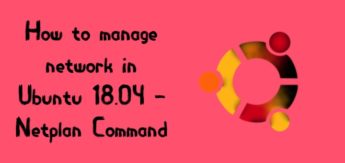For those of you using Ubuntu 18.04 & above, you might have noticed that the way we used to add the static IP address in Ubuntu does not work. Or how do I add multiple IP addresses to single interface or to configure another network interface on Ubuntu? So how do I manage network in Ubuntu ???
That’s what we will discuss in this article, we can manage network in Ubuntu using the new tool, NETPLAN command. Netplan is used together with renderers i.e. Networkd & with NetworkManager. Netplan uses YAML files to configure the network on Ubuntu.
So netplan reads network files from ‘/etc/netplan/’ folder, I have seen different files names under this folder. Most of the time, it’s ‘01-netcfg.yaml’ but in one of my systems, its ‘50-cloud-init.yaml’ or it can also be ‘config.yaml’. We can update the file to make changes to the network. But if you don’t find any file inside this folder then you can run the following command to create a new config file,
$ sudo netplan generate
Recommended Read: Managing network connections using IFCONFIG & NMCLI commands
Also Read: Surf anonymously: Learn to install TOR network on Linux
Now let’s discuss some other examples to help us manage the network in Ubuntu 18.04 & above.
1- Assign IP address using DHCP
Open the configuration file & make the following changes,
$ sudo vi /etc/netplan/config.yaml
network:
version: 2
renderer: networkd
ethernets:
enp3s0:
dhcp4: true
Here, we can change the renderer to NetworkManager instead of networkd as well,
network:
version: 2
renderer: NetworkManager
ethernets:
enp3s0:
dhcp4: true
Now save the file & to apply the changes, run the following command,
$ sudo netplan apply
Now, we can check the IP address, it will be now assigned using DHCP.
2- Assign a static IP address in Ubuntu
To assign a static IP address, open the file & make the following changes,
$ sudo vi /etc/netplan/config.yaml
network:
version: 2
renderer: networkd
ethernets:
enp3s0:
addresses:
- 10.10.1.2/24
gateway4: 10.10.1.1
nameservers:
addresses: [8.8.8.8, 1.1.1.1]
Save & apply changes using the following command,
$ sudo netplan apply
3- Assign multiple IP addresses to a single interface
Open the file & make the following changes,
$ vi /etc/netplan/config.yaml
network:
version: 2
renderer: networkd
ethernets:
enp3s0:
addresses:
- 10.10.1.2/24
- 10.10.1.3/24
gateway4: 10.10.1.1
nameservers:
addresses: [8.8.8.8, 1.1.1.1]
4- Configuring multiple Interfaces with DHCP address
We need not create a 2nd file for another interface, we can add the configuration for the new interface in the same configuration file. To configure 2 network interfaces with DHCP, add the following configuration,
network:
version: 2
renderer: networkd
ethernets:
enp3s0:
dhcp4: true
enp3s8:
dhcp4: true
Save the file & apply the changes using the below-mentioned command,
$ sudo netplan apply
Now we have 2 network interfaces, both with DHCP configured.
5- Configuring multiple interfaces with static IP addresses
To add more than one network interfaces with static IP addresses, add the following configuration,
$ sudo vi /etc/netplan/config.yaml
network:
version: 2
renderer: networkd
ethernets:
enp3s0:
addresses:
- 10.10.1.2/24
gateway4: 10.10.1.1
nameservers:
addresses: [8.8.8.8, 1.1.1.1]
enp3s8:
addresses:
- 10.10.1.3/24
gateway4: 10.10.1.1
nameservers:
addresses: [8.8.8.8, 1.1.1.1]
Now save the file & exit. Apply changes with the following command,
$ sudo netplan apply
These were only some of the commands to manage network in Ubuntu. We can not only assign static IP address in Ubuntu using netplan but we can perform other advanced operations as well using netplan. To get the complete idea of what netplan can do, you can refer to the official documentation as well HERE.
This complete our tutorial, please send in any questions or queries using the comment box below.
